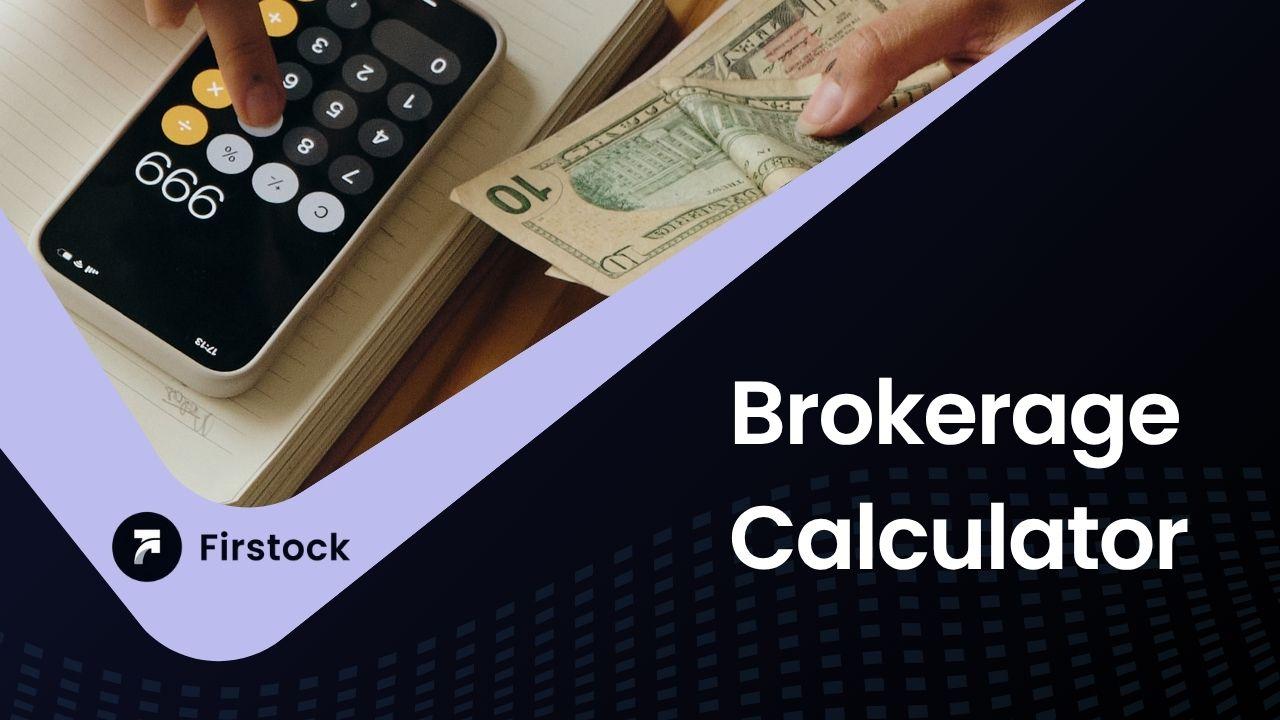Stock Brokerage Calculator – Estimate Charges & Maximise Returns

What is a Stock Brokerage Calculator and Why You Should Care
Have you ever made a trade and later wondered, “Where exactly did my profit go?” Most of the time it’s not just the movement of the share price, but the many hidden costs that take a bite out of your returns. That’s where a stock brokerage calculator steps in—a handy tool to estimate all those fees so your net profit isn’t a surprise.
Imagine you’re sailing across the ocean: the broker, taxes, stamp duty and other charges are like under-the-water currents pulling you off-course. The brokerage calculator is your sonar: it reveals what’s lurking below.
In this article, we’ll walk you through how a brokerage calculator works, what components it includes, how you can make best use of it (especially in India), how to compare across brokers, and how it ties into concepts like trading app in India, discount broker, and even SIP investment.
Use a brokerage calculator, stock brokerage calculator, brokerage charges calculator or share market brokerage calculator to compare on a trading app in India with a discount broker, and even account for SIP investment costs.
What the term “brokerage” really means
When you buy or sell stocks via a broker, they don’t work for free. The fee you pay them for facilitating the trade is called brokerage. This is in addition to various taxes, duties and regulatory charges. So when you hear “brokerage charges”, that includes much more than just what the broker pockets.
For example, in India brokers usually charge a percentage of the trade value or a flat fee for certain segments. A broker may charge, say, 0.3% of the transaction value for delivery trades, or a flat ₹20 for intraday orders. But that’s just one piece of the puzzle.
What is a brokerage calculator, and how it works
A brokerage calculator (or share market brokerage calculator) is a tool—often online—where you plug in the details of your trade (buy price, sell price, quantity, trade type, etc.) and it computes the total cost: brokerage + taxes + duties + other charges.
For example, the online calculator of Zerodha Broking Ltd shows brokerage, STT, exchange charges, GST and stamp duty in one interface.
Another one by Angel One Ltd breaks down brokerage across equity, futures & options, commodity sectors.
Why is this helpful? Because it gives you transparency before you trade. Instead of guessing or finding out later that your profit was eaten by invisible fees, you can estimate upfront and choose the right strategy.
Key components included in a share market brokerage calculator
Let’s break down what many calculators show you (especially in India):
-
Brokerage – The fee charged by your broker.
-
Securities Transaction Tax (STT) – A tax on stock trades.
-
Exchange transaction charges – The fee levied by the stock exchange for executing your trade.
-
GST (Goods & Services Tax) – On the brokerage and service charges.
-
Stamp Duty – State-wise duty for buying/selling shares.
-
SEBI turnover fee / regulatory charges – For the regulator and turnover basis.
-
DP (Depository Participant) charges – If you are taking delivery/selling shares.
-
Other charges – E.g., commodity related taxes, futures options, etc.
Having all these items in one calculator gives you a clearer “net” picture: what you’re really left with.
How to use a brokerage calculator step-by-step
Here’s how you can use one, say for equity delivery trade:
-
Select the trade type (e.g., Equity – Delivery).
-
Enter buy price, sell price, quantity.
-
Choose exchange (NSE / BSE) and state (for stamp duty).
-
Click calculate: you’ll get a breakdown of brokerage + other charges + net profit/loss.
For instance, on the Angel One calculator, you choose segment (equity delivery/intraday/F&O) → enter buy & sell price & quantity → see net P&L. -
Use the result to ask: “Given these charges, what’s my breakeven?” If your expected profit is less than the sum of charges, the trade may not be worth it.
Delivery trades vs intraday trades: cost differences
These two are vastly different when it comes to charges:
-
Delivery trades: You buy shares and hold them for more than one day. The brokerage tends to be higher (percentage-based) and STT on sale side is applicable.
-
Intraday trades: Buy and sell on same day. Often brokerage is flat or lower, but you will still pay STT, exchange charge etc.
For example, some calculators treat intraday trades differently and show lower brokerage. The m.Stock calculator lists intraday brokerage as flat for some segments.
Why it matters: If you’re using a discount broker via a trading app in India, you may find that intraday trades have significantly lower costs, which helps if you’re trading frequently.
How to do a brokerage calculator comparison across brokers
Want to pick the broker who gives you the best deal on costs? Here’s how:
-
Use similar trade inputs (buy price, sell price, quantity, segment) across calculators of multiple brokers (e.g., Zerodha, Angel One, Upstox).
-
Compare the total cost (not just brokerage) from each calculator.
-
See which broker includes fewer add-ons or offers a flatter cost for your type of trade. For example, BrokerChooser provides a brokerage fee calculator to compare across brokers globally.
-
Look at broker type: some are full-service (higher cost, extra services), others are discount brokers (lower cost).
-
Make sure you consider how often you trade. If you trade frequently, small cost differences per trade multiply.
At the end, you’ll know which broker is cheapest for your specific trading style.
Why “discount broker” matters in India and how it affects charges
The term discount broker refers to a brokerage platform that offers minimal services (no heavy research/advisory) and charges much lower brokerage. Many newer trading apps in India operate under this model.
Since your main goal is to trade efficiently at minimal cost, a discount broker helps reduce the “under-water current” dragging your returns. When you combine that with a brokerage calculator you can see your savings clearly.
For example, if Broker A is full-service with brokerage 0.5% and Broker B is discount with flat ₹20 per order, you can plug in the numbers into calculators and see which gives better value for your type of trade.
Linking to a trading app in India: convenience + cost transparency
In India, many brokers offer mobile apps where you can trade, and they include a brokerage calculator built-in or on their site. Examples: Zerodha, Upstox, Groww. For instance, Groww offers a brokerage calculator on its website that explains what charges apply: brokerage, STT, GST, stamp duty. This integration matters because when you’re on a trading app in India:
-
You can estimate charges before placing the order.
-
You can compare across segments (equity, F&O) in one place.
-
You can align your trade size/segment with lowest cost.
In other words, the app + calculator + discount broker = better deals for you.
How SIP investment fits (or doesn’t) with brokerage calculators
Here’s where one term in our keywords—sip investment—comes in. SIP stands for Systematic Investment Plan—common in mutual funds—but when you think of stock markets, you might also do regular small purchases of stocks.
If you’re buying small amounts regularly (like an SIP), then:
-
The brokerage per trade becomes more significant relative to the trade size (because small trade value + flat minimum brokerage = higher % cost).
-
Use the brokerage calculator to estimate how much cost you pay per trade and annually.
-
If you use a discount broker with minimal brokerage, the cost leak is less.
Hence, even though brokerage calculators are often used for day-trading or large trades, they are just as useful (or more) for regular small investments like SIP-style stock purchases.
Common mistakes people make when estimating brokerage costs
Here are a few pitfalls:
-
Ignoring other charges: Only looking at brokerage percentage and forgetting STT, stamp duty, etc.
-
Using wrong trade type: Mixing up intraday vs delivery leads to wrong cost estimates.
-
Not comparing trade size/segment: A broker may be cheap for large trades but expensive for small trades.
-
Forgetting the frequency effect: If you trade often, even a small difference in cost adds up big time.
-
Putting too much faith in the calculator without strategy: A calculator tells costs, not market movement or risk.
By using a good brokerage charges calculator and being aware of these mistakes, you’ll avoid nasty surprises.
Tips to reduce brokerage charges and maximise net returns
Here’s how you can make the most of your trades:
-
Use a discount broker if you don’t need heavy advisory or research.
-
Choose the right trade type (intraday vs delivery) that aligns with your strategy and lowest cost.
-
Use the share market brokerage calculator each time you enter a new trade type or higher value trade.
-
Consolidate trades when possible: larger trades sometimes give lower cost per unit.
-
Regularly review your trading app in India to make sure you’re still getting competitive rates.
-
Factor in SIP investment style: regular small trades mean sensitivity to broker cost—so keep brokerage low.
-
Stay mindful of hidden fees and charges beyond brokerage.
Conclusion – putting it all together
In summary, if you trade or invest in stocks—whether you’re holding them for days, weeks, or doing regular small purchases—the brokerage calculator, stock brokerage calculator, brokerage charges calculator or share market brokerage calculator is your tool to estimate the full cost of trading. Pair that with a trading app in India, and if you choose a discount broker, you’re putting yourself in a strong cost-efficient position.
By understanding what goes into the cost (brokerage, STT, stamp duty, etc.), comparing across brokers, and adjusting your strategy accordingly, you’re not just chasing returns—you’re guarding them. After all, what’s the point of earning on a stock if most of it disappears in fees?
FAQs
1. What is the difference between a brokerage calculator and a normal trade calculator?
A brokerage calculator focuses on estimating costs: brokerage, taxes, stamp duty, exchange charges etc. A normal trade calculator might only compute profit/loss based on buy/sell price and quantity—but ignore hidden costs. Using a brokerage calculator gives you the net picture.
2. Does a brokerage calculator guarantee the actual cost I will pay?
No, it gives an estimate based on the input data and typical charges. Actual cost may differ slightly due to rounding, state changes, segment differences or broker-specific offers. It’s a very useful guide, but not an absolute guarantee.
3. Is the brokerage calculator useful for SIP investments?
Yes. Even though SIPs are usually associated with mutual funds, if you are doing regular stock purchases, the cost per trade matters. A brokerage calculator helps you estimate cumulative costs over time, so you can pick a broker or plan that minimises cost leakage.
4. How often should I compare brokers using brokerage calculator comparison?
Ideally, whenever you change your trading strategy (e.g., more frequent trades, larger trade size, adding F&O segment) or at least once a year. Market competition changes, brokers may update pricing plans, and your cost needs may change.
5. If I use a discount broker and trade via a trading app in India, can I skip using a brokerage calculator?
You could, but it’s unwise. Even discount brokers have taxes, stamp duties, and hidden charges beyond the flat brokerage. Using the calculator ensures you’re fully aware of all charges and not just the headline brokerage rate.





